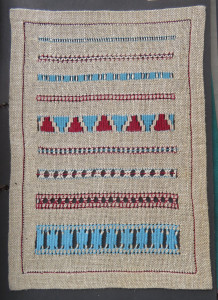Would you believe that the first type of embroidery that was ever created was……….wait for it………….Needle Weaving!! It happened many centuries or even thousands of years BC. Spinning and weaving had already been established of course.
And this is how it happened.

The weaver, having set up his/her loom with warp threads, then wove in the crosswise threads – called the weft. The weft threads were pushed close to each other forming what we know as – fabric. The weaver would leave a space between the rows of weft threads at the point where a hem would be stitched. I think that the next development was the creation of hemstitching which you can see in the top line of stitching in the above photo.
Coloured wool threads were woven into that space between the lines of weft threads forming the first step in needle weaving and the first step in decorating fabric.

This is the needle weaving sampler I made while a student at the Royal School of Needlework. We now remove both the weft and warp threads to form a hemstitched border around a piece of fabric. I do not know when mitering corners was developed.
Many lines of weft threads can be removed leaving space for more complex needle woven designs. Many of these designs are part of the traditional embroidery techniques of eastern Europe.
I remember working on this sampler while travelling from home to RSN on the London Underground. I was weaving in the weft threads at the ends of the design bars. A young lady was strap hanging just in front of me and attentively watching what I was doing. After awhile, she said, “so that is how that is done. I have always wondered and now I know!”
That is a very long term memory! Because, it was truly, a very long time ago!
Very interesting Ann
We learn something new every day.
Thanks for sharing
I used to love doing needlewaving in the dim and distant past. Thank you for reminding me.
Thank you Ann. Your posts are always very interesting and much appreciated. I really like your needleweavivig sampler.
I enjoyed reading the personal touch that you added regarding the history of this kind of early needlework.
Hi Ann,
I am going to send you a 2-page copy from a newish book by Johanna Banck-Burgess on the Celtic textiles found at Eberdingen-Hochdorf. Johanna calls the technique you describe in your blog as ‘flying thread’. It was long thought that the textiles from the grave at Eberdingen-Hochdorf showed ‘true’ embroidery. Instead it is now confirmed that it is this in between thingy; not quite weaving, not quite embroidery. When they tried to recreate one of these textiles it was found that using the flying thread technique is far more time consuming than just using simple back-stitch embroidery to create the same effect. Other textiles found in the grave show the same paradox and it is thought that the extra time involved in making these textiles marked the wearer or owner out as very, very special.
The full reference for the book is: Banck-Burgess, J., 2012. Instruments of power. Celtic textiles. Theiss. ISBN: 978-3-8062-2709-3. The complete text of the book is bi-lingual: German and English.